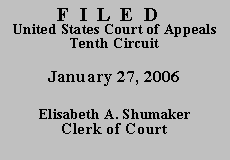

| FERNANDO BUSTILLO,
Petitioner-Appellant, v. ROBERT A. HOOD, Warden, Respondent-Appellee. |
|
Fernando Bustillo appeals the orders entered by the United States District Court for the District of Colorado denying his petition under 28 U.S.C. § 2241 for writ of habeas corpus and motion to reconsider.
In 1991, Petitioner Bustillo was convicted in the United States District Court for the Central District of California of the murder of a fellow inmate, assault with intent to commit murder on a fellow inmate, assault on a federal corrections officer, and possession of a weapon by a prison inmate, all while incarcerated at the United States Penitentiary at Lompac, California. On direct appeal, the United States Court of Appeals for the Ninth Circuit affirmed. See United States v. Bustillo, No. 91-50393 (9th Cir. Mar. 24, 1993), cert. denied, 510 U.S. 854 (1993). In 1997, he filed a 28 U.S.C. § 2255 motion in the district court for the Central District of California, which was denied. See United States v. Bustillo, No. 97-CV-1418 (C.D. Calif. Apr. 21, 1997) (unpublished).
In 2005, while incarcerated at the United States Penitentiary in Florence, Colorado, Petitioner filed a § 2241 petition in the district court for the District of Colorado. The district court denied the § 2241, concluding that the appropriate remedy for Petitioner was under § 2255 in the district court for the Central District of California where he was convicted and not under § 2241 in the District of Colorado. This appeal followed.
Upon review of the record and appellate brief, the court concludes that the district court correctly denied the § 2241. A § 2241 petition is not the proper means to raise the claims alleged by Petitioner. A motion under § 2255 in the Central District of California is the exclusive remedy for Petitioner to challenge his 1991 conviction unless there is a showing that the remedy is inadequate or ineffective. See Haugh v. Booker, 210 F.3d 1147, 1149 (10th Cir. 2000). Courts have stressed that the remedy under § 2255 is inadequate or ineffective only in "extremely limited circumstances." Caravalho v. Pugh, 177 F.3d 1177, 1178 (10th Cir. 1999). The fact that a petitioner is precluded from filing another § 2255 motion fails to establish that the remedy is inadequate. See id. at 1179. And although second or successive applications are restricted under the Antiterrorism and Effective Death Penalty Act (AEDPA), they are not prohibited. See 28 U.S.C. §§ 2244(b)(2), 2255; Felker v. Turpin, 518 U.S. 651, 664 (1996) ("[t]he added restrictions which the [AEDPA] places on second habeas petitions ... do not amount to a 'suspension' of the writ"). Because Petitioner has not established the inadequacy or ineffectiveness of a § 2255 motion, his exclusive remedy is under § 2255 in the district court for the Central District of California.
The district court's May 26, 2005 and June 13, 2005 Orders are AFFIRMED. Petitioner's motion to proceed in forma pauperis is DENIED. The mandate shall issue forthwith.
Entered for the Court
Per Curiam
*. This order and judgment is not binding precedent, except under the doctrines of law of the case, res judicata, and collateral estoppel. The court generally disfavors the citation of orders and judgments; nevertheless, an order and judgment may be cited under the terms and conditions of 10th Cir. R. 36.3.